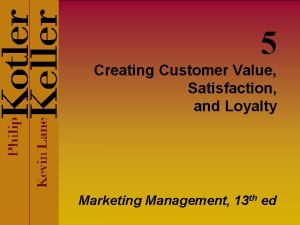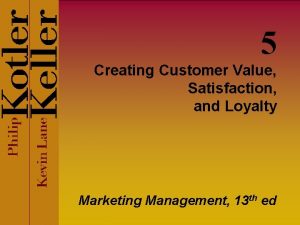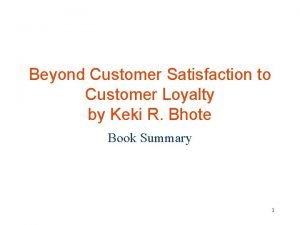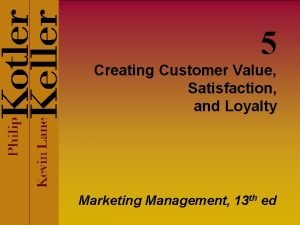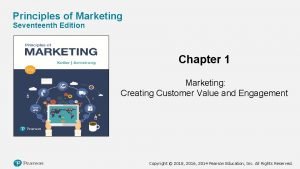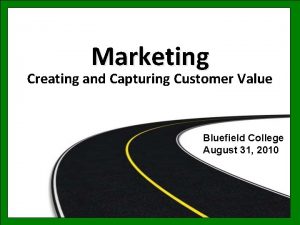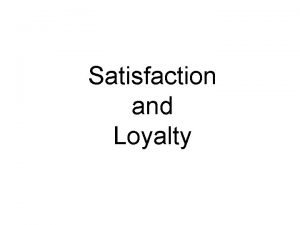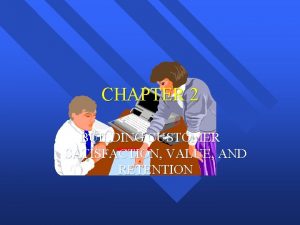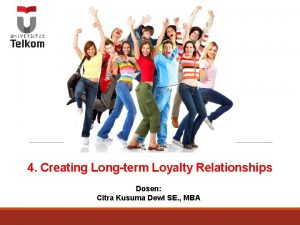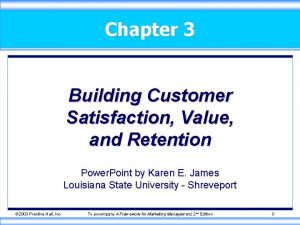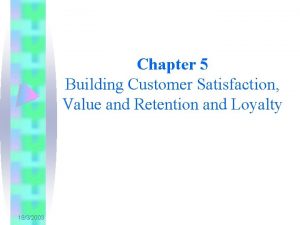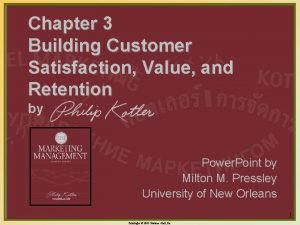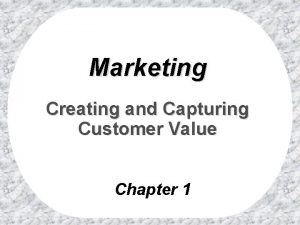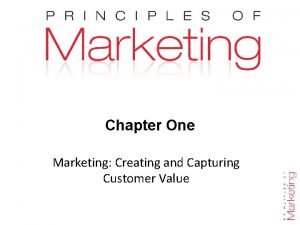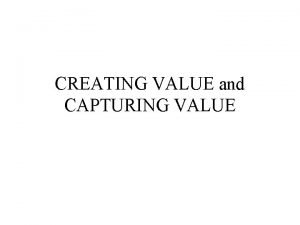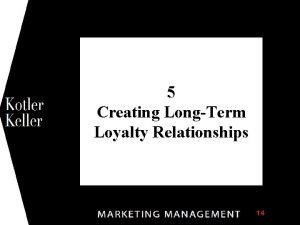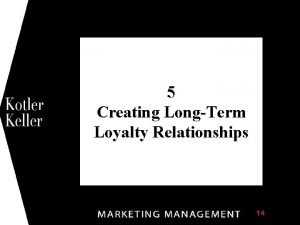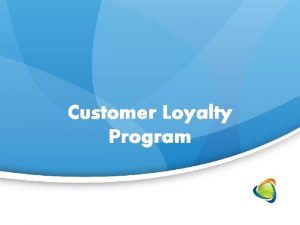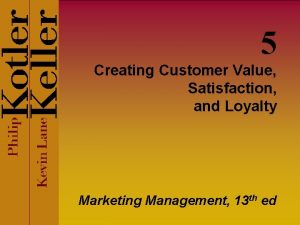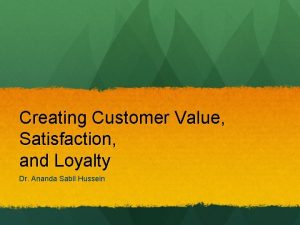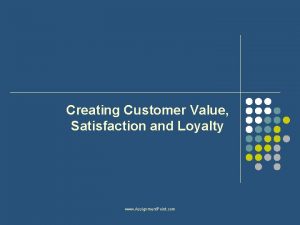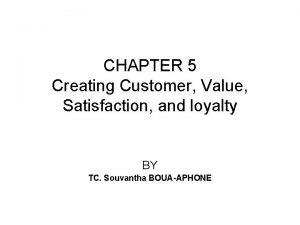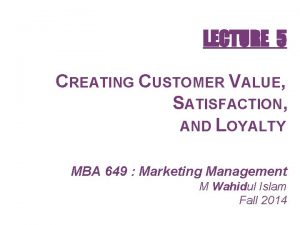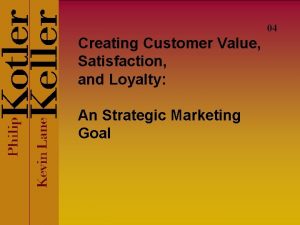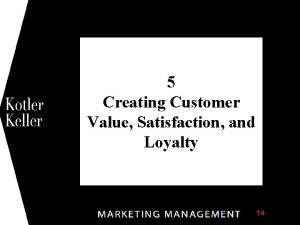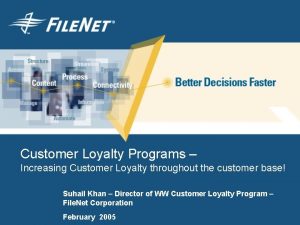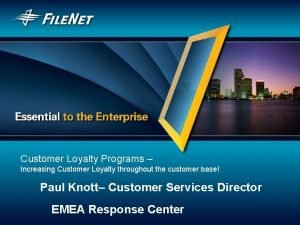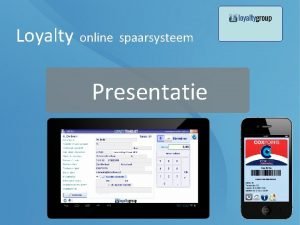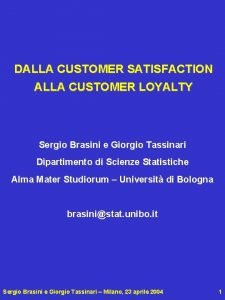5 Creating Customer Value Satisfaction and Loyalty Marketing


















- Slides: 18

5 Creating Customer Value, Satisfaction, and Loyalty Marketing Management, 13 th ed

Figure 5. 1 Organizational Charts Copyright © 2009 Pearson Education, Inc. Publishing as Prentice Hall 5 -2

Figure 5. 2 Determinants of Customer Perceived Value Total customer benefit Total customer cost Product benefit Monetary cost Services benefit Time cost Personal benefit Energy cost Image benefit Psychological cost Copyright © 2009 Pearson Education, Inc. Publishing as Prentice Hall 5 -3

What is Loyalty? Loyalty is a deeply held commitment to re-buy or re-patronize a preferred product or service in the future despite situational influences and marketing efforts having the potential to cause switching behavior. Copyright © 2009 Pearson Education, Inc. Publishing as Prentice Hall 5 -4

The Value Proposition The whole cluster of benefits the company promises to deliver Copyright © 2009 Pearson Education, Inc. Publishing as Prentice Hall 5 -5

Measuring Satisfaction Periodic Surveys Customer Loss Rate Mystery Shoppers Monitor Competitive Performance Copyright © 2009 Pearson Education, Inc. Publishing as Prentice Hall 5 -6

J. D. Power Rates Customer Satisfaction Copyright © 2009 Pearson Education, Inc. Publishing as Prentice Hall 5 -7

What is Quality? Quality is the totality of features and characteristics of a product or service that bear on its ability to satisfy stated or implied needs. Copyright © 2009 Pearson Education, Inc. Publishing as Prentice Hall 5 -8

Maximizing Customer Lifetime Value Customer Profitability Customer Equity Lifetime Value Copyright © 2009 Pearson Education, Inc. Publishing as Prentice Hall 5 -9

Estimating Lifetime Value • • Annual customer revenue: $500 Average number of loyal years: 20 Company profit margin: 10 Customer lifetime value: $1000 Copyright © 2009 Pearson Education, Inc. Publishing as Prentice Hall 5 -10

What is Customer Relationship Management? CRM is the process of carefully managing detailed information about individual customers and all customer touchpoints to maximize customer loyalty. Copyright © 2009 Pearson Education, Inc. Publishing as Prentice Hall 5 -11

Framework for CRM Identify prospects and customers Differentiate customers by needs and value to company Interact to improve knowledge Customize for each customer Copyright © 2009 Pearson Education, Inc. Publishing as Prentice Hall 5 -12

CRM Strategies Reduce the rate of defection Increase longevity Enhance “share of wallet” Terminate low-profit customers Focus more effort on high -profit customers Copyright © 2009 Pearson Education, Inc. Publishing as Prentice Hall 5 -13

Customer Retention • Acquisition of customers can cost five times more than retaining current customers. • The average customer loses 10% of its customers each year. • A 5% reduction to the customer defection rate can increase profits by 25% to 85%. • The customer profit rate increases over the life of a retained customer. Copyright © 2009 Pearson Education, Inc. Publishing as Prentice Hall 5 -14

Figure 5. 5 The Customer Development Process Suspects Prospects First-time customers Disqualified Repeat customers Clients Ex-customers Copyright © 2009 Pearson Education, Inc. Publishing as Prentice Hall Members Partners 5 -15

Creating Customer Evangelists Copyright © 2009 Pearson Education, Inc. Publishing as Prentice Hall 5 -16

Database Key Concepts • Customer database • Database marketing • Mailing list • Business database • Data warehouse • Data mining Copyright © 2009 Pearson Education, Inc. Publishing as Prentice Hall 5 -17

Using the Database To identify prospects To target offers To deepen loyalty To reactivate customers To avoid mistakes Copyright © 2009 Pearson Education, Inc. Publishing as Prentice Hall 5 -18
 What are customer value satisfaction and loyalty
What are customer value satisfaction and loyalty What are customer value satisfaction and loyalty
What are customer value satisfaction and loyalty Creating customer value satisfaction and loyalty
Creating customer value satisfaction and loyalty Beyond customer satisfaction
Beyond customer satisfaction What is customer value satisfaction and loyalty
What is customer value satisfaction and loyalty Chapter 1 marketing
Chapter 1 marketing Core customer and marketplace concepts
Core customer and marketplace concepts Undivided loyalty
Undivided loyalty Building customer satisfaction
Building customer satisfaction Creating long term loyalty relationships
Creating long term loyalty relationships Building customer satisfaction value and retention
Building customer satisfaction value and retention Building customer satisfaction value and retention
Building customer satisfaction value and retention Customer satisfaction value and retention
Customer satisfaction value and retention Capturing value from customers
Capturing value from customers Creating and capturing customer value
Creating and capturing customer value Creating and capturing value
Creating and capturing value Questions about loyalty in relationships
Questions about loyalty in relationships Creating long term loyalty relationships
Creating long term loyalty relationships Fishbone diagram automotive
Fishbone diagram automotive
